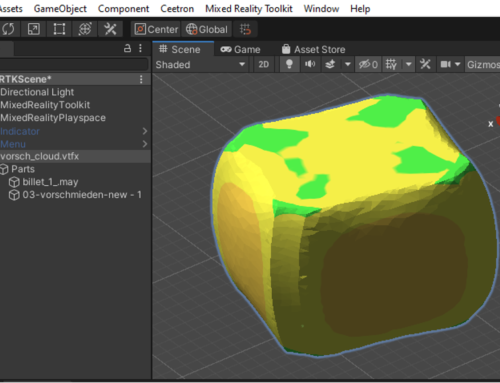(15.01.21) Tønsberg, Norway
This is the usual response we get when we demo VR in the CAE space. For a brief moment the serious, stiff, smart-dressed, important-looking businessman/woman forgets all about the real world and turns into a giggling kid playing with a new toy. Then all of a sudden, realizes the out-of-business character, takes off the headset and tries to put on a serious mask again. But the “harm” has already been done and the discussion that follows is full of ideas on what kind of cool features one could add to the VR-application.
After a while, the heart rate has settled down a bit and the kid has been replaced by an intrigued business-face trying to see how one can use this kind of technology to add value to their own business. And this is the core problem with VR in the CAE space; although cool tech it’s sometimes hard to see the real business case. And that’s the main reason why we @ Ceetron have brought our VR headsets to trade shows, exhibitions, clients, partners for years -> To learn as much as we can on how this kind of technology can give added value to our partners.

One problem we see with VR is that people react differently to it: some get dizzy easily, others are having a hard time using the controllers and so on. The younger generation seems to take it easier than the older generation, but it’s not conclusive. Luckily, there is competition in the VR space which drives both overall product quality up and prices down. Higher resolution, higher frame rate, less screen-door effect +++ helps to make this less problematic.
With competition comes also new tech and with this comes something we @ Ceetron find very interesting, namely AR (Augmented Reality). Or MR (Mixed Reality) as Microsoft likes to call it. Well, MR is more than just the classic AR but that’s a story for another blog.
Observant readers of the Ceetron blogs may recall our earlier post about my trip to the Mixed Reality Dev Days at Microsoft campus in Redmond, May 2019. (If not, you can read about it here. I was lucky enough to be allowed to play around with the new HoloLens2 for a while and pick the developers brains 😉 and I must say I was really impressed with the device… and the brains… In my own brain the HoloLens1 was merely a prototype to showcase the fundamentals of the tech and Microsoft’s way of investigating the market potential and to create enthusiasm for their AR initiative. HoloLens2 on the other hand has the build quality of a real product and I couldn’t wait to get hold of one to play around with in the Ceetron Labs back home. Sadly, this was easier said than done, especially if you come from a small, non-important country like Norway where our main developer office is located. However, last summer we managed to acquire one and immediately started digging into it.

Microsoft is promoting Unity as ‘the’ way to get data into the HoloLens2 by using their Mixed Reality Toolkit (MRTK). Luckily, we already have some experience in getting CAE data into Unity via our “Ceetron CAE Import plugin for Unity”, which I wrote about in this blog. So, it was quite easy to push data from Unity and onto the device.

One good thing about AR devices is that you don’t get dizzy that easily as with VR, due to the real-world reference. It´s just like wearing glasses. Well, big glasses I might add. Like alpine ski goggles. But the HoloLens2 is comfortable enough to wear for a while so it´s not really a big problem.
I was a bit concerned that the Field of View would be too small but, although noticeable, it´s not a huge problem. You´re mostly focusing on the object just in front of you anyway.
Another thing I was concerned about was how well the graphics would be rendered, how many triangles it could handle and how stable the geometry would be in geo-space while walking about in the room. And again, no worries. As with all new tech, the next revision will be better, and the HoloLens has indeed areas that can be improved. But I think Microsoft has managed to design a product with the required minimum spec to be of real use. See for yourself in this short video:
The main takeaway from Redmond was that Microsoft really had something unique and interesting that could be a game-changer for many industries, including CAE. And after playing with this for a while in the office I feel stronger about this than ever.
I mentioned earlier in this blog that one of the challenges is how VR can give added value to the CAE scene. And the questions are the same for AR/MR. The answers may be different from one company to another, but we do see some trends:
- Collaboration – Across domains and disciplines, sharing and collaboration on the same set of data, on any device, anywhere.
- Superimpose simulated results onto real world objects – Think IoT, think digital twins, think real-time result simulations, think real-time monitoring.
Ceetron is in a unique position here since we already have cloud-based CAE streaming technologies ready for the market.
Other areas could be:
- Educational – Training, guides
- Sales & Marketing
Back in the day we had big, expensive Cave-like systems with fixed setup that required dedicated engineers to operate and some of them cost a small fortune. Today, VR has become off-the-shelf hardware with a negligible price-tag, available at your local consumer electronics store just around the corner down the block. (Thank you, Gaming Industry…) Hopefully AR/MR will take the same road, although there are fewer big actors in this field versus VR. But without any doubt, CAE is going XR. And Ceetron want to join in on the ride. Would be awesome if you would join in on the fun with us…







Leave A Comment
You must be logged in to post a comment.